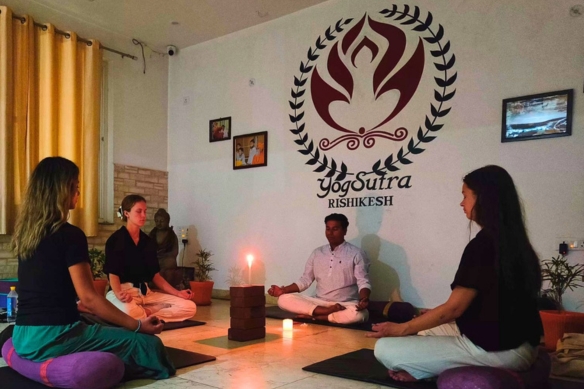Immerse yourself in the ancient art of breath control and meditation, unlocking the secrets of inner peace and holistic well-being. This comprehensive guide seamlessly blends traditional knowledge with modern techniques, providing a step-by-step roadmap for beginners and experienced practitioners. Dive into the profound world of Pranayama and master the art of mindful breathing to increase vitality and clarity. Explore meditation practices that cultivate mindfulness, reduce stress, and increase spiritual awareness. Whether seeking peace in a chaotic world or aiming to deepen your spiritual practice, this guide is your compass to a harmonious mind, body, and spirit. Elevate your life; Start your transformational journey today!
What is the Pranayama?
Pranayama, an ancient yogic discipline, emphasises breath mastery to amplify the essential life force known as "Prana." Rooted in Sanskrit, "Prana" translates to life energy, and "ayama" signifies extension or drawing out. Pranayama involves deliberate breath control through diverse exercises, patterns, and rhythms.
The practice seeks to equilibrate and synchronise the prana flow within the body, fostering physical well-being, mental clarity, and spiritual health. Various pranayama techniques serve distinct purposes, from calming the mind and alleviating stress to boosting energy levels and enhancing respiratory function.
Integral to traditional yoga, Pranayama seamlessly integrates with meditation practices. The belief persists that mastering breath can lead to profound self-understanding and elevated consciousness.
What is the Meditation?
Meditation is a contemplative practice encompassing various techniques to induce relaxation, heightened awareness, and inner peace. Different meditation methods include mindfulness, which encourages observing the present moment without judgment, and concentration, where focus is directed towards a specific object, thought, or activity. Guided meditation, mantra repetition, and transcendental meditation are also commonly practised.Regular meditation has been linked to various mental, emotional, and physical benefits, including stress reduction, improved concentration, and enhanced emotional well-being. It offers a space for self-reflection and can be approached from a spiritual or secular perspective, making it a versatile tool for personal growth, stress relief, or a deeper connection with one's inner self.
Retreat Classes for Pranayam and Meditation:
The Retreat is the simplest and fastest learning program for learning meditation and Pranayama. By joining Meditation and Pranayama Teacher Training in Rishikesh India, you can implement the transformational journey of meditation and Pranayama. It is the art of breath control through extensive pranayama sessions designed to increase the vital life force within you. Exploring different meditation techniques can boost your mindfulness. You can learn the art of delving into the depths of meditation by joining 3-day, 5-day, 7-day and 10-day yoga retreats in Rishikesh. Whether a beginner or an experienced practitioner, these classes cater to all levels, providing guidance and insight to elevate your mind, body and spirit. Join us in this stimulating experience and discover the profound benefits of Pranayama and meditation on your overall health.
Daily Best Practices for Pranayama and Meditation:
Step-by-Step Guide to Pranayama Practice:
- Find a quiet and comfortable place to sit. Ensure good posture on the floor.
- Close your eyes and take a few moments to relax your body. Focus on releasing tension from your forehead, jaw, shoulders, and other areas holding stress.
- Begin with natural, deep breaths. Observe the inhalation and exhalation, feeling the rise and fall of your chest or the expansion and contraction of your abdomen.
Introduction to Pranayama Techniques:
Choose a specific Pranayama technique based on your needs. Common techniques include:
- Deep Diaphragmatic Breathing: Emphasize deep belly breaths.
- Nadi Shodhana (Alternate Nostril Breathing): Balance the body's energy flow.
- Kapalabhati (Skull-Shining Breath): Energetic, rhythmic breaths through the nose.
- If you're a beginner, start with a few minutes of practice and gradually extend the duration as you become more comfortable.
- Concentrate on your breath or the specific Pranayama pattern.
Closing:
Finish your Pranayama session with a few moments of natural breathing. Notice any changes in your body and mind.
Step-by-Step Guide to Meditation Practice:
- Sit comfortably on a chair or cushion with your spine straight. You can also practice meditation while lying down.
- Determine how long you'll meditate, especially if you're a beginner. Start with a realistic timeframe, like 5 to 10 minutes.
- Close your eyes and turn your attention to your breath. Notice the sensation of each inhale and exhale. Use this as an anchor for your thoughts.
- Allow thoughts to come and go without judgment.
- Progressively relax your body, from your toes to the top of your head. Release tension and soften each part of your body.
- Alternatively, you can use a mantra, a visual point, or observe your thoughts without attachment.
- When your chosen time elapses, gradually bring your awareness back to the present. Open your eyes and sit quietly for a moment before resuming your activities.
- Remember, Pranayama and meditation are personal practices, so feel free to adapt these steps to suit your preferences and needs. Consistency is vital to experiencing the full benefits of these practices.




 - Copy.png)

Comments